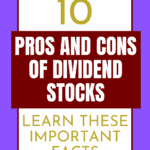THIS POST MAY CONTAIN AFFILIATE LINKS. PLEASE SEE MY DISCLOSURES. FOR MORE INFORMATION.
Dividend stocks are a great investment vehicle for those who want to make money.
They provide an easy way to diversify your portfolio and they offer regular, predictable income.
However, there are also some major drawbacks you should be aware of before investing in dividend stocks.
In this post, I cover 10 pros and cons of dividend stocks so you can decide if it’s the best option for your needs or not.
Table of Contents
10 Big Pros And Cons Of Dividend Stocks
5 Pros Of Dividend Stocks
There are many benefits to investing in dividend stocks.
Here are the biggest ones to focus on.
#1. Additional Income Stream
One of the biggest benefits of dividend investing is an additional stream of income.
In most cases, you will receive cash dividends every quarter from a company.
I say most cases because there are a few number of stocks that pay out regular dividends on a different schedule.
This is a huge advantage for dividend stock investors, especially retirees who want to generate enough passive income to help cover their expenses.
Depending on how much money you have invested in dividend paying stocks, you might be able to withdraw less money from your portfolio as a result, allowing you to live more comfortably or longer on your investments.
Finally, if you are able to, you might be able to invest in a variety of dividend paying stocks so that every month you get paid a dividend.
Having a monthly income as opposed to a quarterly income will make budgeting much easier for you.
#2. Boosts Overall Rate Of Return
Another of the advantages of dividend stocks can also provide a boost to your returns.
If a stock earns 5% annually and has a dividend yield of 3%, you are essentially earning 8% return on this investment, assuming they pay a consistent dividend.
This can allow you to invest in less risky assets and still earn a competitive return.
In the event you are young or you don’t need the cash from dividend paying companies, you can choose to instead reinvest this money.
By using dividend reinvestments to buy more shares, you compound your growth.
Not only do the new shares you buy increase in value, but since you own additional shares, you get a larger dividend payout.
In the beginning, when you don’t have a lot of money invested, your reinvested dividends won’t add up to much money.
But over time, as the value of your portfolio increases, you can earn hundreds of dollars in dividends.
If you keep reinvesting, you will see large increases in the value of your investments.
#3. Preferential Tax Treatment
Dividends are taxed at preferential rates.
Instead of being taxed as ordinary income like bond interest, dividends are taxed at a lower rate.
This is a significant tax advantage as you keep more of your money instead of paying taxes with it.
- Read now: Find out how to invest tax efficiently
And depending on your financial situation, the tax you pay on dividends could be less than capital gains tax you pay when you sell investments as well.
#4. Increase Dividend Payout Rate
Another advantage of dividend stocks is they tend to increase their dividend annually.
While you won’t see an increase of 10%, you might see 2% which will help you keep ahead of inflation.
Over time, this can help you earn a greater overall return on your money.
#5. Lower Volatility
Dividend paying stocks tend to be large cap companies that have stable earnings and growth.
In many cases, these are known as blue chip stocks.
As a result, their stock prices don’t swing wildly with market fluctuations like other growth stocks.
Because of this, you can lower the overall volatility in your investment portfolio by investing in blue chips.
5 Cons Of Dividend Stocks
While there are many benefits to dividend stocks, there are also drawbacks.
Here are the biggest cons of dividend investing.
#1. Lack Of Diversification
While a lot of large companies tend to pay dividends, to get a higher or competitive payout, you need to look to certain asset classes.
For example, a mature industry like banks and utilities tend to pay higher dividends.
But if you invest in 3-4 bank stocks or 3-4 utility stocks, you aren’t truly diversifying your investments.
And you are putting yourself at risk should something happen in that industry.
This sector risk could destroy your portfolio quickly.
Think back to 2008.
While the overall stock market tumbled, if you were primarily invested in bank stocks for the dividends, you got crushed.
If you decide to follow a dividend investing strategy, make sure you are well diversified across many industries.
#2. Tax Inefficiency
One of the biggest drawbacks of dividend investing is it is tax inefficient when compared to investing in companies that don’t pay dividends.
This is because you have to pay taxes on the dividends you receive, regardless if you reinvest them or not.
If you didn’t earn dividends, you wouldn’t have this additional tax to pay.
Another factor that complicates this is qualified dividends and ordinary dividends.
Qualified dividends are dividends that meet special requirements set by the IRS to be taxed at a lower long term capital gains tax rate.
Ordinary dividends are dividends that don’t meet these special requirements.
As a result, they are taxed at your ordinary income tax rates.
So if you are in the 22% tax bracket, your dividend will be taxed at 22%.
To avoid the tax inefficiency of dividends, you can choose to hold them in your retirement plan, where they will be tax deferred.
#3. Investment Risk
Arguably the biggest risk of dividend stock investing is investment risk.
What this means is you might need the dividend income in retirement.
If interest rates are low, yields on bonds will also be low.
As a result, they might not provide enough regular income for you.
So instead of following your asset allocation model based on your risk tolerance, you invest more money into stocks in order to increase your investment income.
While this solves the problem of increasing your income, it also increases your portfolio to a level of risk you aren’t comfortable with.
As a result, if the stock market starts to get volatile, you might lose more money than you want.
Not only does this mean your investments are worth less, but now it will be harder to produce the income you need.
You very well might need to invest more money into dividend paying stocks, meaning taking on more risk, as a result
The bottom line is, don’t focus on the short term, which is dividend income, and ignore the long term risks.
Try to see if there are other ways to boost your income.
Maybe you could look into inflation protected bonds, or alternative investments.
Or you might have to review your budget and cut costs and limit spending while interest rates are low.
#4. Changes To Dividend Payment
While most companies want to make regular dividend payouts, the reality is that sometimes they can’t.
This is a big risk factor you need to account for.
For example, a stock that is paying a healthy 5% annual dividend might hit hard financial times.
In order to survive, they might have to suspend the dividend.
You might think this only hurts you but you would be wrong.
Many of the investors who own this stock are doing so for the dividend earnings.
Now that that is gone, they need to get that income elsewhere.
This means they sell the stock.
Chances are you aren’t the only dividend investor that will sell.
Because there is suddenly a larger supply of sellers and not a great demand for the stock, the share price drops.
It is not uncommon for a stock to drop 10% or more when they announce a stoppage to their dividend.
Understand this isn’t a common event, but it does happen.
Because of this, you need to do your research on the companies you plan to invest in and not just focus on the annual dividend yield.
Make sure they have a solid dividend payment history.
For example, look into the dividend aristocrat list.
These are companies that have a long history of paying dividends and you can invest in them, knowing there is very little chance of them cutting or suspending their dividend payment.
#5. Limited Growth
Dividend paying stocks are mature companies and as a result they have limited future growth potential.
At the same time, the dividends they pay also have a growth limit.
In any given year, you might be seeing a rate of return in the mid single digits.
If you were to invest in small cap stocks, emerging markets stocks, or even large cap growth stocks, there is a good chance you could achieve higher growth rates on your money.
So if you are a younger investor, you might want to put a higher concentration of growth stocks in your portfolio.
This isn’t to say you should avoid dividend stocks, just that you shouldn’t make them the primary asset class in your holdings.
Instead, have a healthy mix of dividend producing stocks as well as non-dividend paying stocks.
Final Thoughts
There are the pros and cons of dividend stocks you need to know.
At the end of the day, dividends are a great way to boost your overall return.
But you can’t let dividends be your only focus.
You need to make sure you have a diversified portfolio that has a level of risk you are comfortable with.
Otherwise, you risk taking chances with your investment, and these chances could derail your financial goals faster than you think.
- Read now: Here’s how to learn what your risk tolerance is
- Read now: Learn 95 investing quotes for success
- Read now: What’s the difference between market timing and time in the market
I have over 15 years experience in the financial services industry and 20 years investing in the stock market. I have both my undergrad and graduate degrees in Finance, and am FINRA Series 65 licensed and have a Certificate in Financial Planning.
Visit my About Me page to learn more about me and why I am your trusted personal finance expert.



